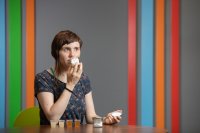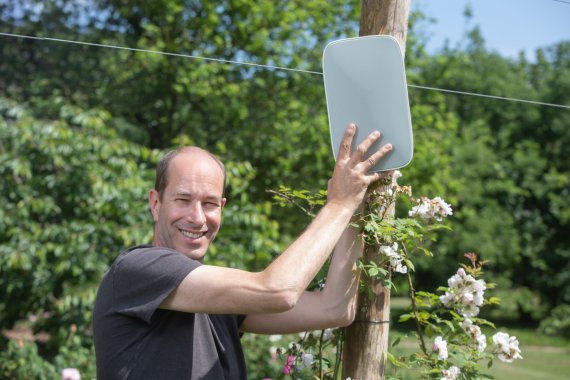William Engelen, Dutch artist and composer.Text Roelof Kleis photos Sven Menschel
The voice of the weather
When the eleventh edition of art exhibition Beelden op de Berg starts on Sunday 17 June, there is one artwork that will draw attention to itself: the Meteofoon by Dutch artist and composer William Engelen. The visible part of the installation is quite modest: four small white speakers mounted on poles in the rose garden at the Belmonte Arboretum. But the point is what you hear.
From the speakers, a woman’s voice will be heard singing: ‘promised – I – garden – never. Or: pardon – beg – rose – you’. This might ring a bell with country music fans. They are words from Rose Garden, the song that Lynn Anderson turned into a classic. ‘I beg your pardon, I never promised you a rose garden.’
Engelen’s Meteofoon has a voice sing four words from the song every other minute, to a different tune. Which words are sung depends on the weather. ‘We wrote a computer programme that compares the current air pressure, humidity, temperature and wind speed every minute with the measurements of exactly one day earlier,’ explains Engelen. ‘The differences are ranked on a scale with five levels above and five levels below zero. Zero means no change.’
The execution is up to nature. The music changes continuously.
William Engelen
That is the science behind the artwork, for which Engelen got the help of meteorologist Bert Heusinkveld (Meteorology and Air Quality). The measurements come from a small weather station that was already in the rose garden. That was what gave Engelen the idea of dusting off his Meteofoon, which he first came up with nine years ago.
So much for the science; now for the art. Each of the 11 levels on the measuring scale corresponds to one of the 11 words from the song. Each of the four loudspeakers therefore expresses one of the four weather variables measured. ‘This gives you a real-time sound installation, which can change every minute due to an unpredictable factor: the weather,’ explains Engelen. ‘I lay down the rules and the structure within certain limits and then the execution is up to nature. In the three months the exhibition is running for, there is never any question of repetition, of a loop. The music changes continuously. That is my translation of the Beelden op de Berg theme “eternal rejuvenation”.’
A taste of body scent
Everyone has their own smell, artificial or not. But what role does that smell play? And can you eat it? A couple of slightly weird experiments around these questions took place in Impulse recently. Twenty-odd students and staff sniffed each other’s armpit odours and tasted products that remind people of sweat. They were visitors at German artist Lauryn Mannigel’s final presentation, called Eat me. As part of the Creative Innovation project, she worked for a while on campus on her study of the affective perception of body scent. Or: the role of body scent in how we experience other people.

Lauryn Mannigel, German artist.
‘Scent and taste are suppressed and devalued senses,’ says Mannigel. In her work, she interrogates why this is so, and how she can use her art to prompt a ‘re-evaluation of scent’. ‘Body scent carries a social stigma. I am looking for ways of reversing that.’
We often pick up scents unconsciously. And those scents evoke an emotion or feeling equally unconsciously. The food and beauty industries know how to exploit this. ‘But how do we judge someone on the basis of the way they smell?’ Mannigel wants to know. And that was what the experiment in Impulse was all about. The visitors let their armpit aroma soak into a little pad of cotton wool for 10 minutes. Then all the participants anonymously assessed samples from five others for the emotion aroused by the smell. Did it make you cheerful, aggressive, calm, cross or even amorous? And would you want to get to know this person?
The second experiment went a step further. In this one the test subjects were given four snacks and a drink that gave off body scents. To develop these, Mannigel had previously interviewed 21 students and staff at WUR. She asked them questions about their perception of smells and tastes, experience with other people’s smells, and the importance of the way someone smells in relationships and friendships. Quite personal questions, she admits. ‘The last question was whether you could imagine being able to eat body scents and if so, what they would taste like. And that doesn’t mean only nasty smells. Bodies can smell nice too.’
Scent and taste are suppressed and devalued senses
Lauryn Mannigel
The recipes for the four snacks and drinks were based on the answers from the interviews. Their flavours varied from fairly tasty to varying degrees of unpleasant and downright gross. Mannigel’s experiments are very different to the way scientists study odours under controlled laboratory conditions. ‘A scientist would never do this. But as an artist I can get away with it. As an artist you must be challenging and interrogate issues. What I want to achieve in the long term is that people are more aware of how scent affects them.’
| Artists in residence and Creative Innovative | In honour of its centenary, WUR has invited artists to turn their creativity loose on the topic of science. Ten artists have been linked up with scientists in a project called Creative Innovation: Art meets science. The idea is that the ensuing cross-pollination generates innovative ideas for both parties. The results will be on display in Impulse at scheduled times. Two artists, William Engelen and Anne Geene were also both Artist in residence in campus for a while. The resulting artworks can be seen in Beelden op de Berg in the Belmonte Arboretum from Sunday 17 June to Sunday 23 September. The work of 10 artists will be exhibited under the title ‘eternal rejuvenation’ – referring to the innovation the university has been contributing to for a century. |
|---|

